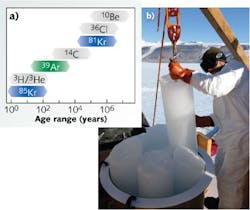Beyond carbon-14 dating, the isotopes of argon (Ar) and krypton (Kr) can be used to date samples over many orders of magnitude older. Using a laser-based technique called atom-trap trace analysis (ATTA), researchers at the U.S. Department of Energy’s Argonne National Laboratory in Illinois have applied a third-generation ATTA-3 instrument to the isolation and detection of the krypton-81 (81Kr) isotope—which has a half-life of 230,000 years—to date water samples as old as 105 or 106 years.
In the experimental setup, an all-diode-laser system at the wavelength of 811 nm is used to deliver a dozen approximately 100 mW laser beams to the atom trap. The trap captures the rare 81Kr atoms when the laser wavelength matches an excitation energy of the chosen isotope; none of the other isotopes are captured, even though their abundances are a trillion times higher. Each trapped 81Kr atom emits a continuous stream of photons that are detected by an EMCCD camera. With this development, 81Kr dating—a concept pursued in the past four decades—is now available to the earth-science community at large. For example, it has already been used to date ancient polar ice from the Taylor Glacier in Antarctica. Contact Zheng-Tian Lu at [email protected].

